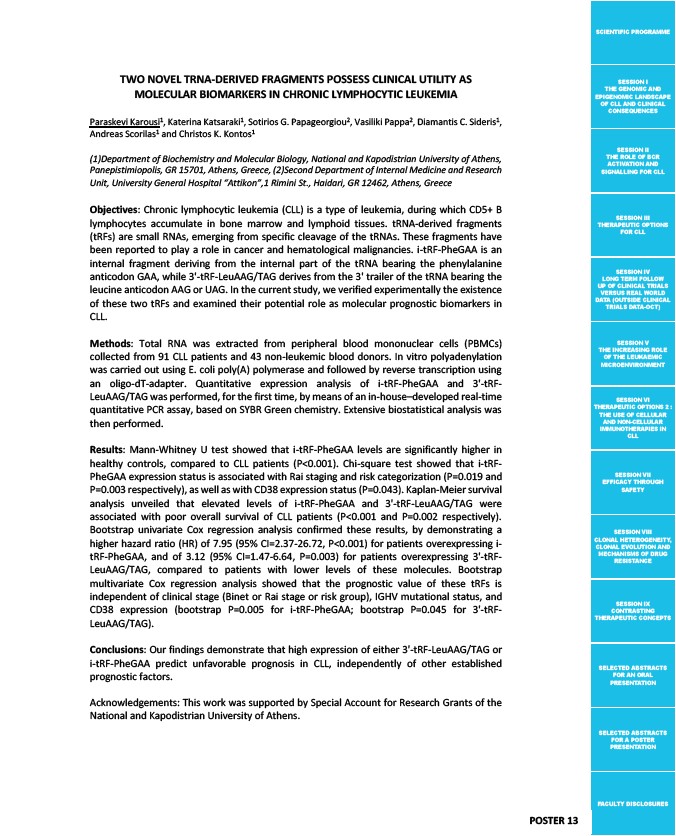
SCIENTIFIC PROGRAMME
SESSION I
THE GENOMIC AND
EPIGENOMIC LANDSCAPE
OF CLL AND CLINICAL
CONSEQUENCES
SESSION II
THE ROLE OF BCR
ACTIVATION AND
SIGNALLING FOR CLL
SESSION III
THERAPEUTIC OPTIONS
FOR CLL
SESSION IV
LONG TERM FOLLOW
UP OF CLINICAL TRIALS
VERSUS REAL WORLD
DATA (OUTSIDE CLINICAL
TRIALS DATA-OCT)
SESSION V
THE INCREASING ROLE
OF THE LEUKAEMIC
MICROENVIRONMENT
SESSION VI
THERAPEUTIC OPTIONS 2 :
THE USE OF CELLULAR
AND NON-CELLULAR
IMMUNOTHERAPIES IN
CLL
SESSION VII
EFFICACY THROUGH
SAFETY
SESSION VIII
CLONAL HETEROGENEITY,
CLONAL EVOLUTION AND
MECHANISMS OF DRUG
RESISTANCE
SESSION IX
CONTRASTING
THERAPEUTIC CONCEPTS
SELECTED ABSTRACTS
FOR AN ORAL
PRESENTATION
SELECTED ABSTRACTS
FOR A POSTER
PRESENTATION
FACULTY DISCLOSURES
TWO NOVEL TRNA-DERIVED FRAGMENTS POSSESS CLINICAL UTILITY AS
MOLECULAR BIOMARKERS IN CHRONIC LYMPHOCYTIC LEUKEMIA
Paraskevi Karousi1, Katerina Katsaraki1, Sotirios G. Papageorgiou2, Vasiliki Pappa2, Diamantis C. Sideris1,
Andreas Scorilas1 and Christos K. Kontos1
(1)Department of Biochemistry and Molecular Biology, National and Kapodistrian University of Athens,
Panepistimiopolis, GR 15701, Athens, Greece, (2)Second Department of Internal Medicine and Research
Unit, University General Hospital “Attikon”,1 Rimini St., Haidari, GR 12462, Athens, Greece
Objectives: Chronic lymphocytic leukemia (CLL) is a type of leukemia, during which CD5+ B
lymphocytes accumulate in bone marrow and lymphoid tissues. tRNA-derived fragments
(tRFs) are small RNAs, emerging from specific cleavage of the tRNAs. These fragments have
been reported to play a role in cancer and hematological malignancies. i-tRF-PheGAA is an
internal fragment deriving from the internal part of the tRNA bearing the phenylalanine
anticodon GAA, while 3'-tRF-LeuAAG/TAG derives from the 3' trailer of the tRNA bearing the
leucine anticodon AAG or UAG. In the current study, we verified experimentally the existence
of these two tRFs and examined their potential role as molecular prognostic biomarkers in
CLL.
Methods: Total RNA was extracted from peripheral blood mononuclear cells (PBMCs)
collected from 91 CLL patients and 43 non-leukemic blood donors. In vitro polyadenylation
was carried out using E. coli poly(A) polymerase and followed by reverse transcription using
an oligo-dT-adapter. Quantitative expression analysis of i-tRF-PheGAA and 3'-tRF-LeuAAG/
TAG was performed, for the first time, by means of an in-house–developed real-time
quantitative PCR assay, based on SYBR Green chemistry. Extensive biostatistical analysis was
then performed.
Results: Mann-Whitney U test showed that i-tRF-PheGAA levels are significantly higher in
healthy controls, compared to CLL patients (P<0.001). Chi-square test showed that i-tRF-PheGAA
expression status is associated with Rai staging and risk categorization (P=0.019 and
P=0.003 respectively), as well as with CD38 expression status (P=0.043). Kaplan-Meier survival
analysis unveiled that elevated levels of i-tRF-PheGAA and 3'-tRF-LeuAAG/TAG were
associated with poor overall survival of CLL patients (P<0.001 and P=0.002 respectively).
Bootstrap univariate Cox regression analysis confirmed these results, by demonstrating a
higher hazard ratio (HR) of 7.95 (95% CI=2.37-26.72, P<0.001) for patients overexpressing i-tRF-
PheGAA, and of 3.12 (95% CI=1.47-6.64, P=0.003) for patients overexpressing 3'-tRF-LeuAAG/
TAG, compared to patients with lower levels of these molecules. Bootstrap
multivariate Cox regression analysis showed that the prognostic value of these tRFs is
independent of clinical stage (Binet or Rai stage or risk group), IGHV mutational status, and
CD38 expression (bootstrap P=0.005 for i-tRF-PheGAA; bootstrap P=0.045 for 3'-tRF-LeuAAG/
TAG).
Conclusions: Our findings demonstrate that high expression of either 3'-tRF-LeuAAG/TAG or
i-tRF-PheGAA predict unfavorable prognosis in CLL, independently of other established
prognostic factors.
Acknowledgements: This work was supported by Special Account for Research Grants of the
National and Kapodistrian University of Athens.
POSTER 13